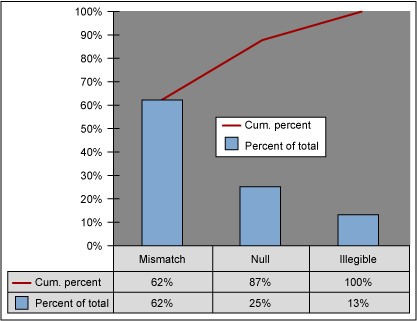
Moving information electronically offers tremendous opportunities for cost efficiencies and improved levels of customer satisfaction for the banking industry. But paperless processes also carry heightened risks for failure. A single process breakdown, when automated within a high-speed electronic world, can result in problems for hundreds of thousands of customers. One such process is check imaging – potentially a huge opportunity for reduced costs and happier customers, but if poorly executed, a huge legal liability. This is a banking issue of global proportions. Deutsche Bank’s Alex Brown projects that a quarter of the world’s large banks will be implementing check imaging within the next two years.
In this case study Lean Six Sigma was used as the method of extracting the benefits of the imaging process, while negating the potential headaches that can occur in a poor process.
What is Lean Six Sigma? Many people have heard of Six Sigma and know that it deals with reducing defects, improving quality and eliminating variation. Lean is a discipline focused on improving process speed and eliminating waste. Lean Six Sigma is the synergistic union between the two, as quality improves speed and speed improves quality. By integrating Lean speed and Six Sigma quality, the rate of improvement in quality, cost and speed increases much faster and goes much further than either discipline could achieve separately.
Reducing the Risk with Paperless Transactions
The required rate of improvement in this case study was urgent. The stakes were high for the client. Undoubtedly, the business case for imaging checks is strong. Supplying customers with electronic images of canceled checks instead of returning the actual checks significantly improves costs by reducing outlays for staff, transportation and postage. Additionally, the case for imaging relates to improved customer service, transaction speed and fraud prevention. Moreover, it is a stronger business case today than it was a few years ago. Fraud has increased – it currently costs the industry between $12 billion and $16 billion a year, according to Carreker Corp. And the cost of electronic storage is now from one-tenth to one-twentieth as expensive as it was just four years ago, according to Bank Administration Institute (BAI).
But poor execution of check imaging carries a huge downside. It can impact a bank in three broad areas: Customer retention, cost and legal ramifications. In this case:
- Unhappy customers – Image mismatching (i.e. when a customer’s check is incorrectly matched to another customer’s account) was causing customers to turn away. The service failed to meet customers’ expectations and was causing concern about security. As customers began to use the service more, delays in accessing their checks became an issue.
- Higher costs – The value proposition for imaging is rooted around its impact on efficiency and cost. In this case, the high degree of mismatching was requiring the efforts of an entire full-time team to rectify the issues.
- Potential lawsuits – The Privacy Act and the Patriot Act have increased the need for information to be accurately stored and appropriately communicated. Violating the Privacy Act – albeit in error – leaves financial institutions open to lawsuits from those individuals and corporations whose information went astray.
Identifying Levers for Improvement
In the beginning the client was not focused on mismatching, but rather simply defects within the imaging process. They knew they had a problem, but not sure where. There were three main areas of focus that determine quality in the imaging process:
- Images are available.
- Images received are correct (alternative: mismatched images).
- Images are legible.
A Pareto analysis was used to graphically depict the contribution of each type of defect to the total. The output: 62 percent of defects fell under the mismatch category.

As illustrated in the figure above, the greatest opportunity lay in solving the issue of mismatches.
What kind of opportunity exists in banking today? To have a Six Sigma level of image integrity means 99.9997 percent are properly indexed. Currently, banks are between three and four sigma. In other words, for every one million items a bank processes per day 6,210 to 66,800 images are defects and up to 41,416 images are mismatched.
From Root Cause to Solution
In this case study, the key was to identify what lay behind the mismatching errors. The team documented two root causes. The first root cause was network failures. The second variety was created when there was a major hardware malfunction at the time of capture and the sorter operator did not follow proper recovery procedures.
The first action was to implement a critical to customer safeguard, ensuring the errors did not pile up at the customers’ doors. The team concluded that by implementing a tracking number checkpoint, mismatches would be caught during capture – in other words, before they reached the customer. The mismatches could then be quickly rectified. The second action was to implement improved training and sorter operator incentives so as to ensure proper recovery procedures at the time of malfunction.
The team also built a value stream map of the process which included key performance data such as wait times, setup times, rework loops and processing times. Creating the map highlighted wasted time and effort that usually isn’t apparent, even to people embedded in the process. Each step was categorized into value-add or non-value-add, and the team was able to identify and eliminate significant waste and dramatically decrease cycle time by removing non-value-add steps in the process. All told, the team was able to cut the cycle time by 50 percent, raising productivity levels and driving out $500,000 in cost.